When you think of “side hustle,” do you think of building a multi-million dollar brand or making some extra change after work and becoming a ride-share driver? Well, for us “normal” folk, it’s most likely the latter, but for celebrities, building a multi-million dollar brand seems like the norm, and in a sense, a rite of passage.
The entrepreneurial pursuits of celebrities such as Jessica Alba, Selena Gomez, Jennifer Lopez, and Kylie Jenner have saturated industries across the board, and today the bar is higher than ever for the success of a celebrity brand.
Five years ago, a celebrity could get away with putting their name and face on whatever they came across, whether it was a fragrance, hair care, or beauty line, and earn some quick cash and exposure. But now, the stakes are higher and the average consumer is increasingly scrutinous of celebrity brands entering the market — a well-known name and face are no longer good enough.
In order to stand out as a celebrity-backed brand today, there must be purpose backed with authenticity. A celebrity brand must add value with whatever they bring to the market — exemplifying quality and solving a significant problem or need existing in the market. The most successful brands backed by celebrities are the ones that focus on long-term growth due to a specific positioning strategy or customer needs they meet and satisfy. The celebrity’s involvement should not be the only distinguishing factor for these types of brands — the quality and value-added should be, as well as the community they build. Some of the most successful celebrity brands are the ones you may not initially know a celebrity is behind in the first place. A brand must be unique, and have its own personality rather than relying on the celebrity’s personality and prowess. While there is no exact formula for success, there are some major dos and don’ts you should know when building a celebrity brand.
The Dos
1. The Proof is in the Pudding
Do: Have Purpose and Passion Behind the Brand
Setting out to make a brand that derives from passion rather than profit-seeking ambition is noticed and valued by the average consumer. In order to stand out the celebrity needs to be involved and in the driver’s seat with direction for the brand and back that with passion. If there isn’t that, consumers can see through the act.
Some questions worth considering are:
- Is there a need in the market?
- Would consumers value what product I am putting out?
- Am I, as an already established celebrity, willing to go the extra mile to put the right team together to make this brand successful?
Let’s look at George Clooney and Rande Gerber’s tequila company, Casamigos, as an example.
The first few elements that put this brand in a position to succeed are the celebrity’s spontaneity in the creation of the brand. Both men, established in Hollywood in their own ways, had adjoining homes in Mexico where they started developing their own tequila for fun, and more for personal use. They eventually decided to sell it to the public in 2013.
Rande Gerber said that what was important for them when they decided to make this a brand and publicly sell the tequila, “…was that we have the best tequila, but we make it affordable for everyone. George doesn’t need the money, I didn’t need it… it wasn’t the reason behind launching a tequila. We wanted everyone to be able to drink it and not be exclusive”.
Both of these men saw an opportunity to share something they were passionate about with the world, and that is what drove them. Passion trumped profit-seeking ambition which is important for a celebrity brand to see. Educating themselves on what the consumer needs as well as where their brand fits in the market- and truly putting the work in to do so – that’s the key.
Do: Have a Quality Product
The single most important aspect of a celebrity brand — especially if we were to (hypothetically) strip the celebrity aspect away, for instance — is the quality of the product. No matter how great the launch is, no matter how many millions of followers the celebrity has, there needs to be a great product and thought-out brand positioning in order to ensure strong differentiation, stand the test of time, and retain consumers in the long term. Doing so requires a mix between the celebrity’s passion and personal involvement with the collaboration of industry experts and advisory boards. There needs to be a large prioritization on sourcing the best ingredients and creating a product that consumers will value for the actual benefit it provides rather than the celebrity name behind it.
Shay Mitchell is a celebrity who goes the extra mile to differentiate her stardom from her brands, so much so, that many consumers don’t know the brands that she has founded and continuously works on today. Travel brand BEIS was solely founded by Shay who currently serves as the CEO, and tequila seltzer brand Onda was co-founded by Shay. These brands are able to stand alone without the celebrity name and face on everything that the brand does — a quality found in many successful celebrity brands today.
In the case of Casamigos, Rand says that “when a new batch comes out he’ll send a bottle, and George and I will taste it”. This reinforces their involvement with the brand and the product, which consumers notice and like to see. Not only that but having a product that demonstrates quality is crucial for a high lifetime value and long-term customer retention.
Do: Bring on Industry Experts
Bringing on the right people to be involved in your brand is key to a quality product line and building immediate credibility. Behind the best celebrity brands are industry experts matched with celebrity passion.
As with every celebrity brand, it is important to build a team of professionals who will bring expertise and industry experience to the products. With every successful celebrity brand comes an incredible team behind closed doors. For example, Kim Kardashian released her new skincare line, SKKN, this year, where she enlisted the help of famed facialist and skincare entrepreneur, Joanna Czech, to assist in her formulations. Hailey Beiber partnered with Michael D. Ratner to create Rhode from the ground up and hired a full-time team of six women to reinforce her message of woman empowerment, and the list goes on.
In the case of Casamigos, George and Rande enlisted the marketing expertise of Mike Meldman, who is the founder and CEO of Discovery Land, to come on as a third co-founder for their celebrity alcohol brand. They knew they needed his entrepreneurial experience to become a success, rather than riding on their fame. In addition, Casamigos has a master distiller responsible for ensuring the quality and consistency of every tequila batch.
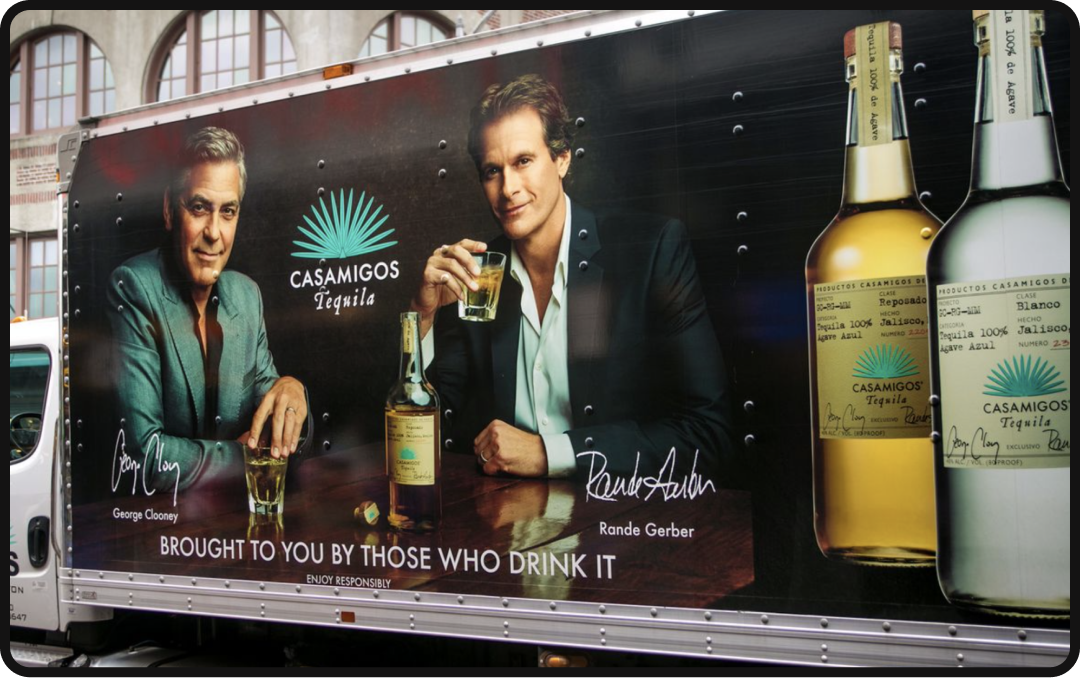
2. Preparing for Takeoff: Landing the Launch
Do: Have a well-thought-out launch.
Be strategic and have a well-thought-out plan to gain exposure and reach your target consumer. A well-thought-out and time-intensive launch is what’s required to stand out as a celebrity brand today. Rhode by Hailey Beiber launched in June, and Hailey and her team put together a launch strategy that was detailed, well thought out, and timely, as it needed to be. Let’s take a look at Rhode as an example, and see what worked for Hailey when launching her skincare line.
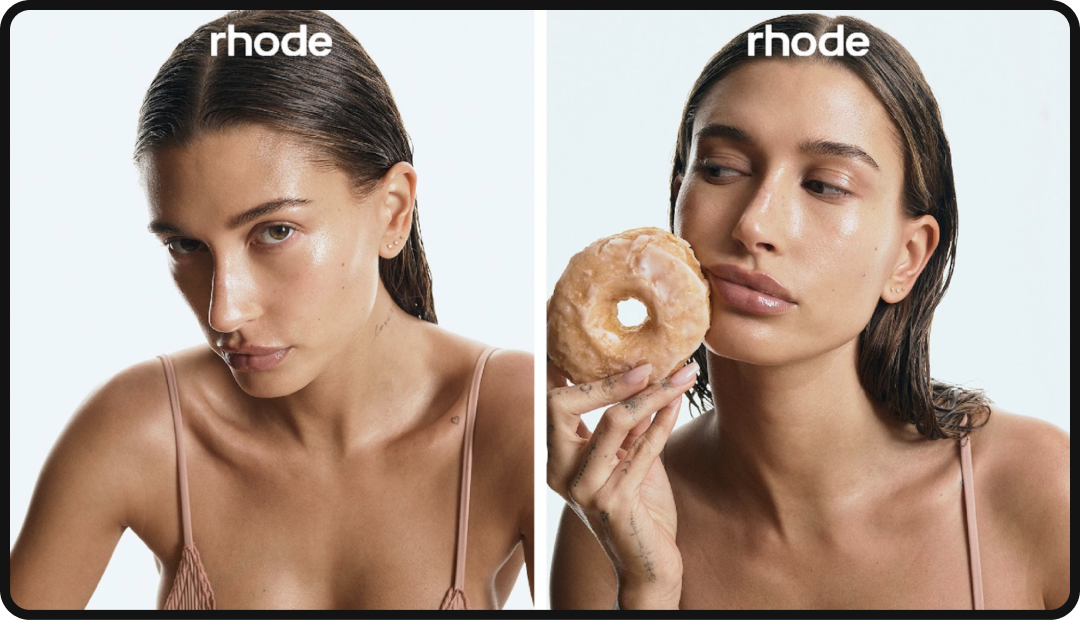
Do: Determine your personal relationship to the cause.
It’s incredibly important to ensure the brand aligns with the values and passions of the celebrity. For years, Hailey Beiber has been vocally passionate about her skin and has flaunted her shiny cheekbones all over social media and tabloids alike. So, when she announced Rhode, a skincare brand, it didn’t feel like she was squeezing into a category she didn’t belong in, which is the first major requirement of celebrity brand success.
Do: Align your social channels with the tone and direction of the brand.
Curate well-thought-out partnerships, and schedule a full PR circuit. These are some of the main drivers of building anticipation and gaining exposure for the brand before initially launching.
Hailey hosted Hyrum, a skincare creator known for educating his audience on skincare ingredients, on her YouTube channel where they candidly tried products and discussed all things skincare. Celebrities partnering with popular and relevant creators is a way to not only gain exposure but to tap into an audience who may not already be a fan of the celebrity, yet are willing to try products recommended by their favorite creator. Creators also carry a more authentic and down-to-earth reputation among the masses than A-list celebs.
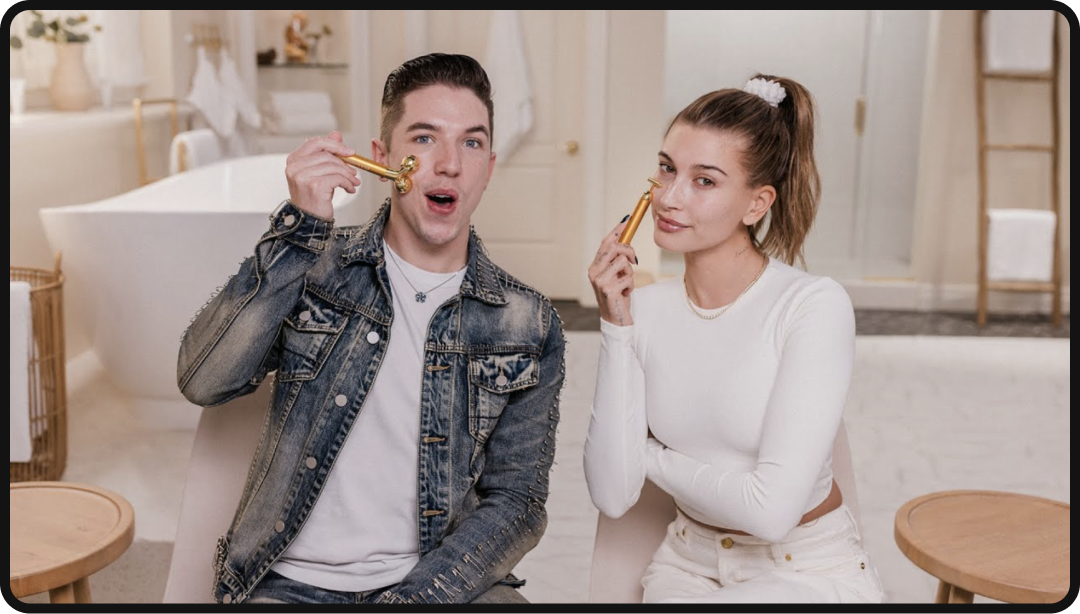
Co-branding and well-thought-out collaborations are another way to gain exposure and curate buzz before launching a new brand. Hailey partnered with the boutique, LA-based, grocery store Erewhon to make a limited-edition “skin” smoothie. While Erewhon is a relatively small brand and may seem like a random partnership, its buzz and attention on social media are astonishing. All of the “it” influencers and celebrities aspire to have a smoothie with Erewon because not only is it the most expensive, and most talked about grocery store on social media, it naturally generates organic UGC, leading to lots of exposure. The $17 smoothie prompted TikTok users to film themselves trying the expensive drink to see if it was worth the money and analyze whether the ingredients would really promote glowing skin.
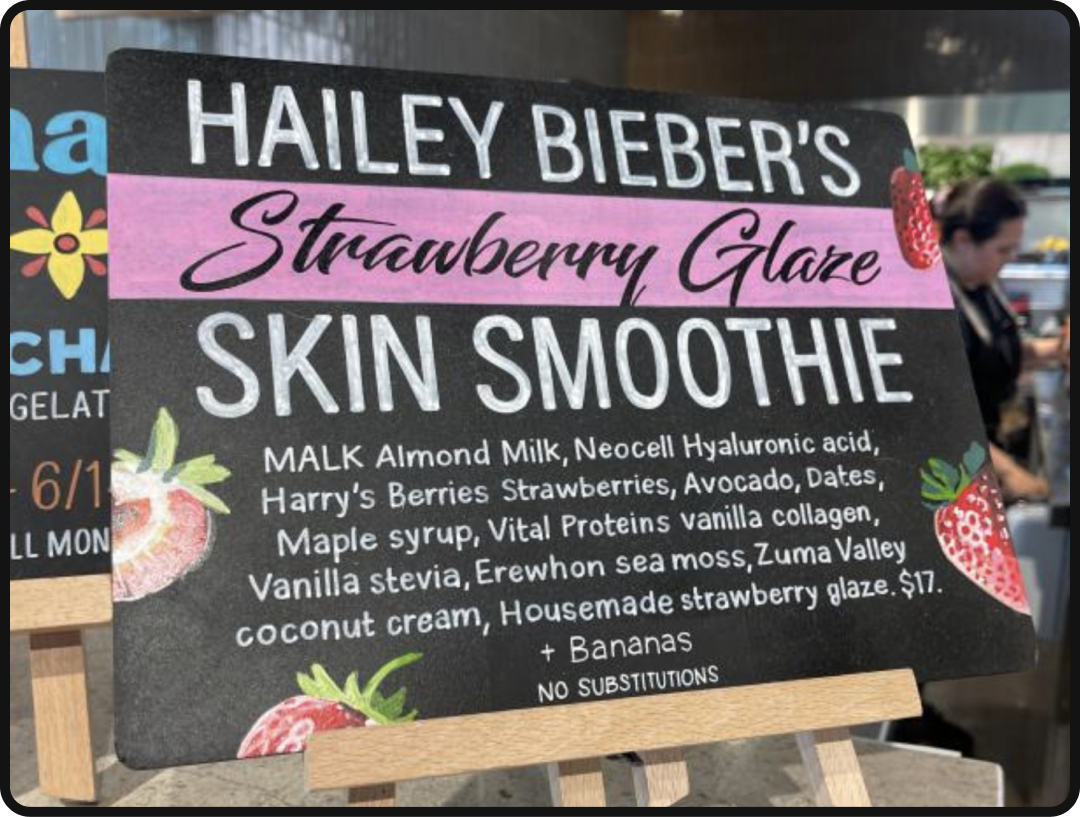
Hailey also had quite the star-studded party for the launch of Rhode. Not only were all the hottest celebrities on the guest list, but very carefully picked creators and influencers. The reason these brand events and parties are so important is because of the organic content that comes from them. The common denominator with these launch strategies: amplifying brand awareness in a more organic way
3. Social Media Strategy
Do: Utilize User Generated Content to display authenticity and drive social proof.
User-generated content (UGC) is the name, authenticity is the game. Sparking buzz about your brand to, in turn, prompt organic UGC is beneficial for a brand in a number of ways. Not only can you repost this content to your own organic social channels, but they can be used as ad creative that feels more authentic, and can be shared on the brand’s website as testimonials further driving social proof.
To further drive community engagement and harness the power of UGC, it’s important to have an internal person or team concentrated on identifying community members that align with the brand, sending them products, and then getting their honest reviews in the form of content. Having this process curated on the backend gives the brand more control over the organic content that is being put out while also contributing to the conversation and community around the brand’s products.
Do: Collaborate with creators and influencers who align with your brand
Leveraging the power of influencers and creators, both micro and macro, as a celebrity brand is important. As some influencers have started to rise to the fame level of certain celebs, fans and consumers are still finding these internet personalities more relatable and authentic. Creators and influencers alike feel like a friend, and someone their followers can really trust. Partnering with these influencers and creators when building a brand is important because it taps into their various audiences and niche. Essentially amplifying brand reach and again providing social proof — which is arguably more important for celebrity brands as compared to traditional brands.
Do: Build advocacy and promote growth loops with UGC
SKIMS, Kim Kardashian’s shapewear line has had great success with leveraging the power of social media and influencers to build brand awareness and advocacy. By carefully selecting influencer and creator partnerships the brand can spark un-paid UGC by viewers and fans for SKIMS to use.
When viewers see their favorite influencers wearing SKIMS bodysuits in their Instagram story, unboxing a SKIMS PR package on TikTok, or a “Get Ready With Me” YouTube video featuring the famous SKIMS dress – viewers, and fans will be influenced to buy. If the product matches or exceeds expectations, the goal is that these customers will be inspired to make content about that purchase and product. This is a great example of a growth loop- something important for all brands to implement. The UGC content is created, it then validates the brand to a new audience, the new audience then purchases from the brand, and in turn that new audience will create UGC.
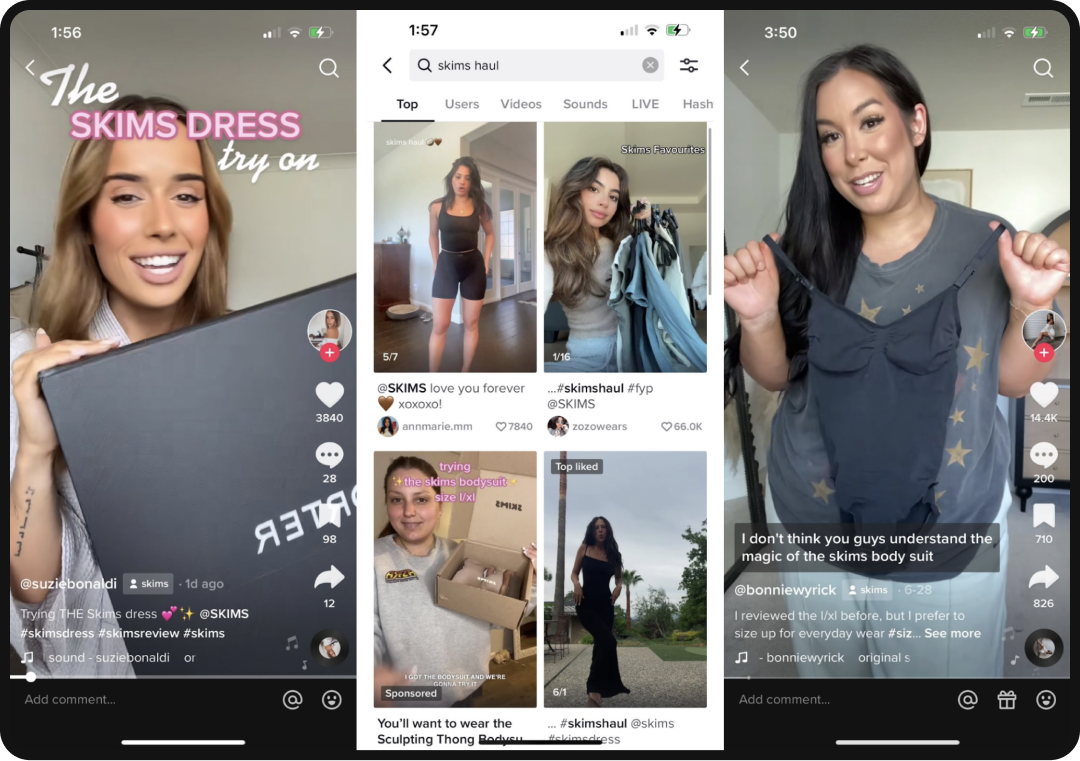
4. Standing for a Cause
Do: Align your brand with a cause that feels authentic to your values and the brand itself
As a celebrity brand, it is important to use that amplified voice and reach to support a good cause that is meaningful to the celebrity as well as authentic to them. It feels ingenuine to partner with a charity or pledges your proceeds to something that doesn’t align with who are as a celebrity and what you stand for in general. As a celebrity, usually, these brands are more of a passion project than an attempt to put food on the table, so, this gives more room to tie giving back and amplifying a great cause as a part of the brand. To ensure the cause will resonate with your audience and community members, it’s important to perform market research ahead of the brand’s launch. While it may be important to the celebrity, it should also be impactful to potential consumers.
Take Selena Gomez’s brand Rare Beauty as an example. From day one, Selena made a “rare impact” on a large part of her brand and what it stands for. Consistency is key here, have a mission and stick with that mission. Rare impact aims to increase access to mental health support in educational settings, but Selena doesn’t stop at having a simple “donate” tab on her website. The Rare beauty site houses a blog with various articles relating to mental health as well as a page listing accessible resources and support for those struggling with mental health. Rare beauty ties this mission into their brand in a large way, and authentically — Selena herself states that figuring out how to manage her own “mental health hasn’t always been easy”.
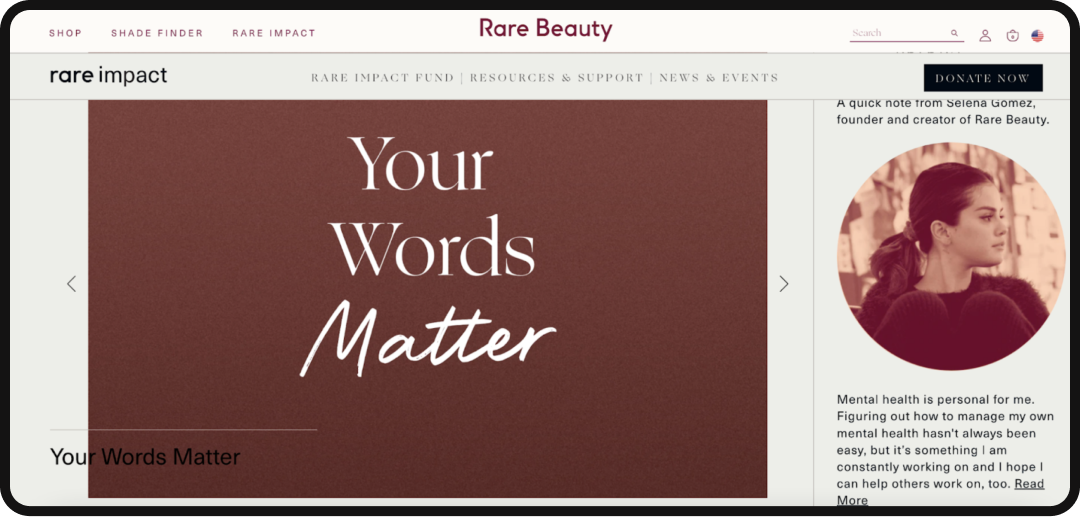
Do: Implement a long-tail strategy
For celebrity brands, with any campaign, it’s important to consider the long-tail strategy — especially when it comes to philanthropic efforts or inclusivity. The long-tail strategy is essentially realizing profits from selling large volumes of more niche products, rather than selling larger numbers of a reduced amount of more popular, easy-to-find items. SKIMS by Kim Kardashian recently released their adaptive line – geared to customers with limited mobility. The undergarment designs prioritize functionality and ease. This new release is not out of the blue – SKIMS was founded with the emphasis and prioritization of inclusivity with their sizing, colorways, and now accessibility. By reinforcing their mission of inclusivity, being consistent with the commitment, and tapping into a niche and unmet needs in the marketplace they are broadcasting that they are aligned with the values of customers — even if it’s not relevant for mass markets.
This is okay, your brand will never be for everyone. Walking the walk, not just talking the talk.

The Don’ts
1. Celebrity Brand Fatigue
With every celebrity, there is usually a brand following shortly behind the explosion of fame. Being a celebrity with a brand isn’t new, innovative, or something consumers are excited to see — the actual product quality and the thoughtfulness behind a brand are what sets it apart. Take the celebrity name and face away from the brand, it should be able to be just as successful. There is so much fatigue in this market that celebrities must work overtime to overcome the skepticism. Don’t believe high follow count, and household recognition is enough to make a celebrity brand a success today.
This ties back into authenticity as mentioned before, the skepticism in this industry is widespread, doesn’t conform to being another inauthentic celebrity brand. The New York Times compiled the opinions of a wide range of consumers and experts, here’s what they had to say on the topic of celebrity brand saturation:
Don’t: Be transactional
Consumers are aware of how transactional celebrity brands often are. Selling a product to rake in some quick cash rather than creating a brand based on passion and interest. Again, this is why it’s so important to only build a brand around passion rather than profit-seeking ambition. One of the most common mistakes is constantly seeking out new consumers while losing focus on retention and community. Sustainable growth is rooted in meaningful relationships, and building those doesn’t happen overnight, or with the intention of purely making a sale.
Advocacy and referrals come from a consumer who feels connected to the brand, which will eventually expand your reach. Social validation is the new mechanism for growth and social proof, which will come once the brand commits to building community rather than constantly converting new customers.
Lastly, lead with the product rather than the celebrity. Consumers will feel as though the brand and products need to rely on the celebrity face to make a sale rather than leading with a product-driven strategy. Take Gwyneth Paltrow’s brand Goop as an example. She has so many products and so many different product lines from skincare to jewelry to clothing. Trying to be everything for everyone quickly comes across as profit-seeking rather than community-building and passion-derived.
Don’t: Set unrealistic expectations
Celebrities building a brand can make a quality product line through research, industry experts, and overall putting the effort in. But, even if it is a quality product line, sometimes that can be questioned by the way that celebrity endorses the brand or product by setting unrealistic expectations around that.
Promising its benefits as a celebrity that has Botox, fillers, and a facial every week does not set a realistic expectation for consumers about your products and makes them question whether it’s the product or simply the skin of a well-manicured celebrity. Because of social media and the consumer expectation of social validation, brands will not be able to get away with unrealistic expectations.
Through UGC a brand will quickly be identified prioritizing quality and results or not. SKKN by Kim Kardashian may have a quality product and may produce great skin results for users, but UGC will quickly debunk if it’s the skincare product she claims is making her skin look like that or the filler and facials she often gets.
Don’t: Underestimate the effort needed
Building a quality brand with a strong value proposition is no easy feat. Celebrities must have the same ambition and passion that someone without an already established following has. If the effort isn’t present and isn’t transparent, it is not going to be able to survive or prosper long-term. The 2017 disaster of the Fyre Festival serves as a cautionary tale when it comes to the effort needed for a brand launch and successful execution. The musical festival in the Bahamas was promised to be a luxury experience promoted by stars such as Bella Hadid and Kendall Jenner. The disastrous results of this effort show that there needs to be more than a pretty marketing strategy to bring an idea to life. Execution and effort should not be taken lightly. They made the mistake of thinking if they could make the sales, and make the festival look good, that it would actually be successful, but failed at making any meaningful effort beyond their marketing initiatives.
2. The Influence of Conglomerates on the Celebrity Brand Wave:
Don’t: Dilute Your Brand
Celebrity brands have become increasingly normalized, the barrier to entry is low, and we see them everywhere. Here’s why:
Celebrity names such as Marilyn Monroe, Shaquille O’Neil, Catherine-Zeta Jones, and more than you’d ever imagine are available for licensing. Essentially, a manufacturer can decide to put one of these celebrity names on something they’re selling, for a price. The consumer is then under the impression they’re getting that certain celebrities product when in reality, it’s more than likely a generic product that has been sourced from their factory and sold with the celebrities face and name on it. Licenses products quickly became too saturated in the market.
Another reason celebrity brands are working overtime in today’s market to stand out is the decline of licensing and the shrinking of major holding companies over the past few years. Celebrity and legacy brands alike were heavily resourcing these companies to create their products, which lead to some muddied waters about where exactly products from these brands are coming from as there has become increased transparency among informed consumers. Don’t dilute your brand by selling your name and expanding into too many categories.
This isn’t as prevalent anymore but it’s where the celebrity brand originally got its bad name — and now emerging celebrity entrepreneurs are paying the price for this and working overtime to establish a legitimate, quality brand, that would succeed with or without their name attached to it.
Don’t: Outsource the hard work
Another reason celebrity brands have started to saturate the market in such a rapid way is due to a select amount of companies who essentially act as “incubators” for a large number of celebrity brands. Beach House Group is an example of one of these companies. They are responsible for Kendall Jenner’s Moon Orcal Care, Millie Bobbie Brown’s Florence by Mills, and more. Companies like these either work with the celebrity or create the brand first and then bring on a celebrity after. Either way, the goal is to build these brands quickly and push them to the consumer as quickly as possible, which is not the ideal scenario for a celebrity brand.
The ways of celebrity brand licensing have still left a bad taste in the mouths of many successful conglomerates. Whether it’s hesitancy to work with celebrity brands in any capacity or being more selective when acquiring a celebrity brand. Estee lauder companies for example (owners of brands such as Clinique and MAC cosmetics) steer clear of celebrity brands altogether. John Demsey, executive group president of Estée Lauder companies, says he has “worked with hundreds of celebrities, but there won’t be a brand based entirely on one”. This is yet another reason why celebrities need to put in the work to create a brand around authenticity, passion, and quality, because of not only consumer doubts but industry doubts as well.
In a Nutshell…
The density of celebrity brands in the market has drastically risen the bar for emerging new ones. There is a responsibility to prove the brand is more than just a cash crab, as well as the authentic passion behind the celebrity building of the brand. It starts with a long, well-thought-out launch strategy that informs the consumer of the product offering, taps into a niche using influencers and creators, collaborations that align with the emerging brand for exposure, and a star-studded launch party doesn’t hurt either.
Upon the launch of the brand, user-generated content is key for social proof and testimonials to be used across all brand platforms. The products need to be able to stand alone without the celebrity name behind them, so when marketing the products to consumers, they must ask themselves, how would this product sell without the celebrity exposure? Ensuring quality is key. Doing so with the backing of an experienced advisory board and collaborating with an industry professional will result in a quality product line.
In today’s market, a celebrity name isn’t enough to attract a buyer. In fact, many consumers steer clear of celebrity brands altogether because of the saturation in the market and quality concerns. To overcome this, the brand must be well-thought-out, align with the image and values of the celebrity, and have qualities that could stand alone and succeed without a celebrity name.





